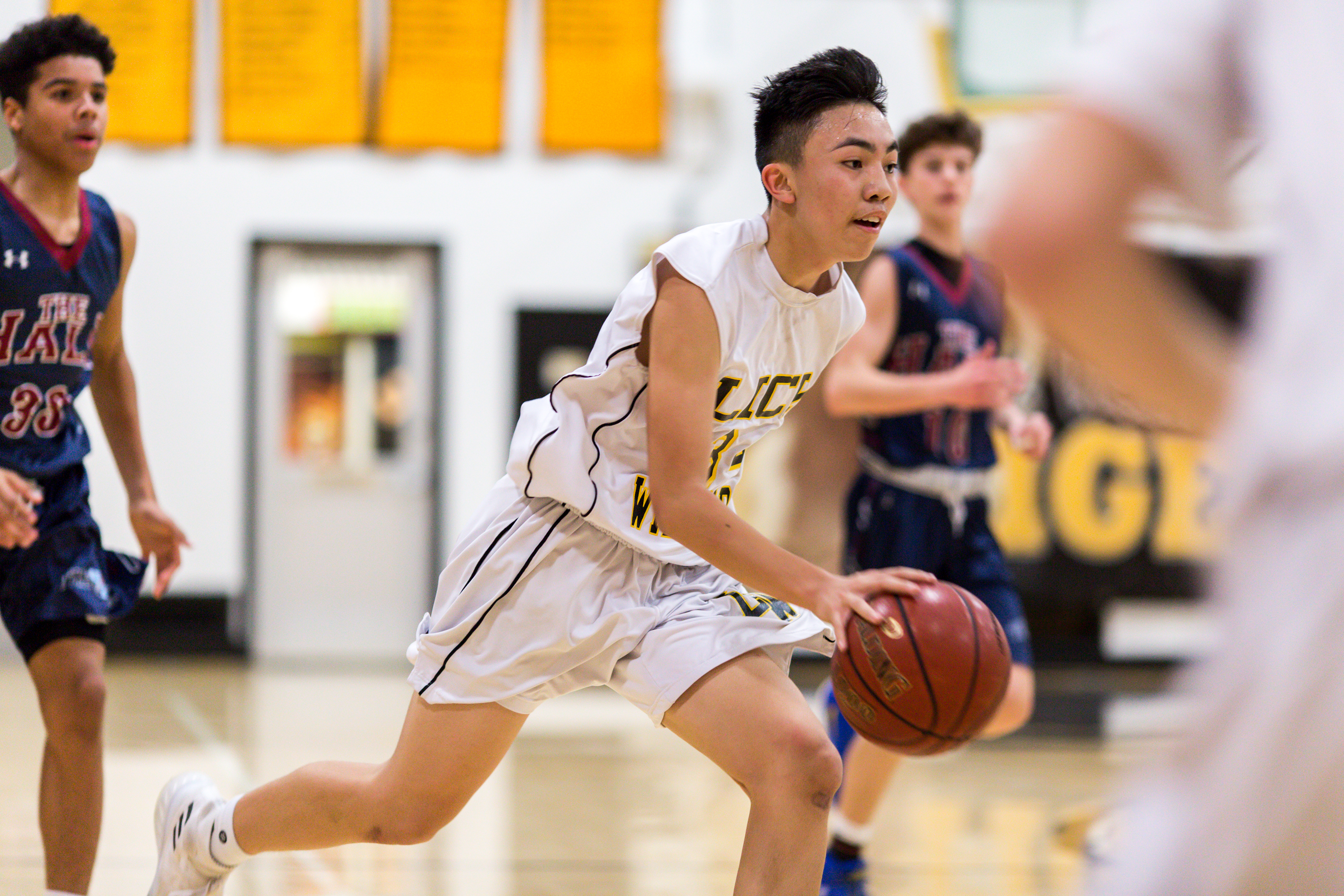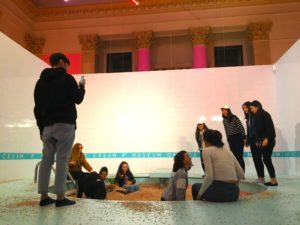It’s no secret that some of the world’s most elite athletes are creatures of habit. One need not venture far into the ranks of high level athletes to hear that victory comes from a careful balance of intense training and a little help from the supernatural. Lucky socks, a special breakfast, or abstention from shaving are the rabbit’s feet of the sporting world. After talking to a few of Lick’s superstar competitors, it is clear that high schoolers, like professional athletes, treasure their lucky charms.
Although the superstitious behaviors themselves are unlikely to give a competitive edge, the home field advantage-like familiarity that comes with routine can certainly boost an athletes’ confidence, a key in unlocking peak performance. A 2006 study from the Journal of Applied Social Psychology analyzed the pre-game routines of elite athletes in order to evaluate possible psychological benefits of superstitious routine. They were careful to outline the difference between superstitions and useful preparation, the former being defined as, “unusual, repetitive, rigid behavior that is perceived to have a positive effect by the actor, whereas in reality there is no causal link between the behavior and the outcome of an event.” After analyzing the rituals of almost 200 elite soccer, volleyball, and hockey players, they found that the primary function of superstitions is to manipulate the athletes’ locus of control and “reduce psychological tension.” Basically, superstitions are confidence boosters.
Four years after the Van Lange-Schippers Study, German psychologist Lysann Damisch led an experiment where participants were required to throw golf balls at a target, with half of the subjects being told by the facilitator, “I’m keeping my fingers crossed for you.” Those who were convinced that they had luck on their side threw more accurately than those who did not— backing the case for superstitions as a way to increase self-efficacy, and apparently, success.
Former Red Sox third baseman and famed power hitter Wade Boggs is perhaps one of the most recognized proponents of ritualistic pre-game behavior. During warm-ups, he always had batting practice at 5:17 p.m. on the dot, fielded exactly 150 ground balls, and entered the dugout in four steps. Boggs was most-known for his pre-game meal of only chicken, and drawing the Hebrew symbol for life (“chai”) in the dirt before each at-bat, even though he was not Jewish. Although the crowd of parents and sibling spectators during a BCL Volleyball game doesn’t quite match the stakes at Fenway, confidence-boosting routines are still a mainstay. The following are specific anecdotes from a few of Lick’s standout athletes.
“Volleyball is a sport that every point rides on you not messing up, so I have become very superstitious… to limit my mistakes,” explained Gigi Buckner ‘19. Buckner reserves a specific outfit only for game days, and changes her hairstyle until she finds one that seems to have luck behind it; “This year, we kept losing to a certain team during the regular season, and I kept changing the way I put up my hair to find the one that would work [until] we finally won.” When the whistle blows, she always steps into position behind the “head, heart, hands” design on the gym floor, calling on the Tiger spirit to keep her passes sharp and feet quick.
When Alison Savage Brooks ‘19 lines up for a cross-country race at Lindley Meadow, she doesn’t mess around with her routine. Pre-race lunchtime is always the same: a toasted ciabatta roll with avocado and bacon on one side, and peanut butter, banana, and honey on the other. Before the gun goes off, she takes a power pose, putting her hands in the air and taking three deep breaths. She also takes to heart the punchline of the women’s cross-country cheer that’s always shouted during the pre-race huddle–“suck it up princess”—to get her ready for the lactic acid burn of racing 5,000 meters.
Naomi Locala ‘20, a high level swimmer for the Palo Alto Stanford Aquatics team, never cools down with the same stroke that she has just raced. “When I was younger,” Locala said, “I thought that during my post-race cooldown, you weren’t allowed to do the stroke that you had just swam in the race… by the time I realized it wasn’t a rule it had become a superstition, and I thought it would make me do badly in my next race.” The majority of her pre-race rituals and good luck charms originated from swimming for the local YMCA swim team as a nine year old; “When I was younger, I had these purple goggles and I had to wear the purple goggles for every race.” Locala remembered that when the model was discontinued, it was a “big deal,” and she had to trade them for the lucky blue goggles she currently sports in all of her races. Whenever she lines up for an event, she does a “streamline” (a swimming technique check), asks the person in the next lane what the distance and stroke is (“just to make sure”), and claps her hands together a few times when she steps onto the block. A more recent addition to her repertoire of superstitions is never listening to music from her own headphones—“either I steal somebody else’s headphones, or don’t listen to music at all, because every time I do that I race badly.” Locala cites her ritualistic behavior as a way to maintain control of her pre-race routine, and “set myself up for success.”
Jeanne Moreno ‘20 truly runs the gamut when it comes to superstitions. Common among runners, she eats a toasted bagel with almond butter and honey on race day, and wears the team-issue ribbon in her hair. However, that is where the run-of-the-mill rituals end. Her white LWHS sweater is a mainstay during warmups, and she “must squeeze Viva Donohoe ‘20’s forearm at the starting line.” She also says a quick internal prayer for all runners including herself. Perhaps most significant, though, is her playlist: “Mo Bamba” by Sheck Wes is always blasting in her earbuds on the bus ride to the race.
Ryan Chin ‘21 always crosses himself with the father, son, and holy spirit symbol before he walks onto the gym floor for a basketball game. “That’s an ode,” he explained, “to my semi-Christian upbringing, and also to my grandmother and great grandmother… who taught me that hard work and drive leads to success.” The men’s varsity basketball team also has a team-wide routine of listening to “Country Roads” by John Denver on the bus ride to away games. “When we have a mic on the bus, we’ll usually do a little freestyle,” Chin said.
Although most rituals tend to orbit around an illusion of control, Will Roos ‘19, a midfielder for SF Elite Academy and Lick-Wilmerding varsity men’s soccer, uses his superstitions as acknowledgment of the things that he does not have power over. By wearing one of his shin guards a bit askew so that the Nike symbol is upside down, he reminds himself that that “things in each game won’t always go my way, but I need to stay focused on what I can control.” Roos also keeps a specific Spotify playlist to get him ready to play, with “songs that can hype myself up.” He divulged that the majority was rap, specifying artists like Ski Mask the Slump God, Mac Miller, and Lil Wayne, but that there was also some EDM.
Before Eddie Taylor ‘21 takes his position at second base in a LWHS baseball game, he always readies himself for the inning with a short jog along the outfield wall. When he’s in the pitching rotation for the Ball Club Bruins club team, he makes sure to check his pocket for his lucky charm— a one dollar bill. “However,” Taylor said, “when my dad realized that I was taking money out of his wallet in order to fund for my superstition, he put a stop to it.”
more accurately than those who did not—backing the case for superstitions as a way to increase self-efficacy, and apparently, success.
Former Red Sox third baseman and famed power hitter Wade Boggs is perhaps one of the most recognized proponents of ritualistic pre-game behavior. During warm-ups, he always had batting practice at 5:17 p.m. on the dot, fielded exactly 150 ground balls, and entered the dugout in four steps. Boggs was most-known for his pre-game meal of only chicken, and drawing the Hebrew symbol for life (“chai”) in the dirt before each at-bat, even though he was not Jewish. Although the crowd of parents and sibling spectators during a BCL Volleyball game doesn’t quite match the stakes at Fenway, confidence-boosting routines are still a mainstay. The following are specific anecdotes from a few of Lick’s standout athletes.
“Volleyball is a sport that every point rides on you not messing up, so I have become very superstitious…to limit my mistakes,” explained Gigi Buckner ’19. Buckner reserves a specific outfit only for game days, and changes her hairstyle until she finds one that seems to have luck behind it. “This year, we kept losing to a certain team during the regular season, and I kept changing the way I put up my hair to find the one that would work [until] we finally won.” When the whistle blows, she always steps into position behind the “head, heart, hands” design on the gym floor, calling on the Tiger spirit to keep her passes sharp and feet quick.
When Alison Savage Brooks ’19 lines up for a cross-country race at Lindley Meadow, she doesn’t mess around with her routine. Pre-race lunchtime is always the same: a toasted ciabatta roll with avocado and bacon on one side, and peanut butter, banana, and honey on the other. Before the gun goes off, she takes a power pose, putting her hands in the air and taking three deep breaths. She also takes to heart the punchline of the women’s cross-country cheer that’s always shouted during the pre-race huddle–“suck it up princess”—to get her ready for the lactic acid burn of racing 5,000 meters.
Naomi Locala ’20, a high level swimmer for the Palo Alto Stanford Aquatics team, never cools down with the same stroke that she has just raced. “When I was younger,” Locala said, “I thought that during my post-race cooldown, you weren’t allowed to do the stroke that you had just swam in the race…by the time I realized it wasn’t a rule it had become a superstition, and I thought it would make me do badly in my next race.” The majority of her pre-race rituals and good luck charms originated from swimming for the local YMCA swim team as a nine year old. “When I was younger, I had these purple goggles and I had to wear the purple goggles for every race.” Locala remembered that when the model was discontinued, it was a “big deal,” and she had to trade them for the lucky blue goggles she currently sports in all of her races. Whenever she lines up for an event, she does a “streamline” (a swimming techniquse check), asks the person in the next lane what the distance and stroke is (“just to make sure”), and claps her hands together a few times when she steps onto the block. A more recent addition to her repertoire of superstitions is never listening to music from her own headphones—“either I steal somebody else’s headphones, or don’t listen to music at all, because every time I do that I race badly.” Locala cites her ritualistic behavior as a way to maintain control of her pre-race routine, and “set myself up for success.”
Jeanne Moreno ‘20 truly runs the gamut when it comes to superstitions. Common among runners, she eats a toasted bagel with almond butter and honey on race day, and wears the team-issue ribbon in her hair. However, that is where the run-of-the-mill rituals end. Her white LWHS sweater is a mainstay during warmups, and she “must squeeze Viva Donohoe ’20’s forearm at the starting line.” She also says a quick internal prayer for all runners including herself. Perhaps most significant, though, is her playlist: “Mo Bamba” by Sheck Wes is always blasting in her earbuds on the bus ride to the race.
Ryan Chin ’21 always crosses himself with the father, son, and holy spirit symbol before he walks onto the gym floor for a basketball game. “That’s an ode,” he explained, “to my semi-Christian upbringing, and also to my grandmother and great grandmother… who taught me that hard work and drive lead to success.” The men’s varsity basketball team also has a team-wide routine of listening to “Country Roads” by John Denver on the bus ride to away games. “When we have a mic on the bus, we’ll usually do a little freestyle,” Chin said.
Although most rituals tend to orbit around an illusion of control, Will Roos ’19, a midfielder for SF Elite Academy and Lick-Wilmerding varsity men’s soccer, uses his superstitions as acknowledgment of the things that he does not have power over. By wearing one of his shin guards a bit askew so that the Nike symbol is upside down, he reminds himself that that “things in each game won’t always go my way, but I need to stay focused on what I can control.” Roos also keeps a specific Spotify playlist to get him ready to play, with “songs that can hype myself up.” He divulged that the majority was rap, specifying artists like Ski Mask the Slump God, Mac Miller, and Lil Wayne, but that there was also some EDM.
Before Eddie Taylor ’21 takes his position at second base in a LWHS baseball game, he always readies himself for the inning with a short jog along the outfield wall. When he’s in the pitching rotation for the Ball Club Bruins club team, he makes sure to check his pocket for his lucky charm—a one dollar bill. “However,” Taylor said, “when my dad realized that I was taking money out of his wallet in order to fund for my superstition, he put a stop to it.”







